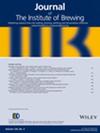求助PDF
{"title":"Evaluation of six commercial koji on the formation of biogenic amines and higher alcohols in rice wine","authors":"Fengyang Qin, Zhengyun Wu, Wenxue Zhang","doi":"10.1002/jib.696","DOIUrl":null,"url":null,"abstract":"<p>Commercial koji are increasingly used as the microbial inoculum in the production of rice wine. This study reports on the use of six commercial koji on rice wine brewing and shows that the microbial composition varied significantly among the different koji. Of the koji, AQ (<i>An Qi</i>) and YB (<i>Yi Bin</i>) contained fewer microflora but exhibited higher starch degradation and wine production efficiency. The Two-way Orthogonal PLS model and Pearson correlation analysis suggests that the presence of biogenic amines in rice wine was related to contaminating microorganisms in the koji including <i>Lactobacillus</i>, <i>Kosakonia</i>, <i>Pantoea</i>, <i>Ralstonia, Kosakonia</i> and <i>Pantoea</i>. The formation of higher alcohols is related to <i>Saccharomyces</i> species. Screening of beneficial yeasts with low production of higher alcohols and avoiding contamination by unwanted bacteria are suggested for improving the quality of rice wine. © 2022 The Institute of Brewing & Distilling.</p>","PeriodicalId":17279,"journal":{"name":"Journal of The Institute of Brewing","volume":null,"pages":null},"PeriodicalIF":2.4000,"publicationDate":"2022-06-27","publicationTypes":"Journal Article","fieldsOfStudy":null,"isOpenAccess":false,"openAccessPdf":"","citationCount":"2","resultStr":null,"platform":"Semanticscholar","paperid":null,"PeriodicalName":"Journal of The Institute of Brewing","FirstCategoryId":"97","ListUrlMain":"https://onlinelibrary.wiley.com/doi/10.1002/jib.696","RegionNum":3,"RegionCategory":"农林科学","ArticlePicture":[],"TitleCN":null,"AbstractTextCN":null,"PMCID":null,"EPubDate":"","PubModel":"","JCR":"Q3","JCRName":"FOOD SCIENCE & TECHNOLOGY","Score":null,"Total":0}
引用次数: 2
引用
批量引用
Abstract
Commercial koji are increasingly used as the microbial inoculum in the production of rice wine. This study reports on the use of six commercial koji on rice wine brewing and shows that the microbial composition varied significantly among the different koji. Of the koji, AQ (An Qi ) and YB (Yi Bin ) contained fewer microflora but exhibited higher starch degradation and wine production efficiency. The Two-way Orthogonal PLS model and Pearson correlation analysis suggests that the presence of biogenic amines in rice wine was related to contaminating microorganisms in the koji including Lactobacillus , Kosakonia , Pantoea , Ralstonia, Kosakonia and Pantoea . The formation of higher alcohols is related to Saccharomyces species. Screening of beneficial yeasts with low production of higher alcohols and avoiding contamination by unwanted bacteria are suggested for improving the quality of rice wine. © 2022 The Institute of Brewing & Distilling.
6种商品曲对黄酒中生物胺和高级醇形成的评价
商品曲越来越多地用作黄酒生产中的微生物接种剂。本研究报道了6种市售曲在黄酒酿造中的应用,结果表明,不同曲的微生物组成差异显著。其中,AQ(安淇)和YB(一宾)菌群较少,但淀粉降解率和制酒效率较高。双向正交PLS模型和Pearson相关分析表明,黄酒中生物胺的存在与侵染黄曲菌(Lactobacillus)、Kosakonia、Pantoea、Ralstonia、Kosakonia和Pantoea等微生物有关。高级醇的形成与酵母菌种类有关。为提高黄酒质量,建议筛选高醇产量低、避免有害菌污染的有益酵母菌。©2022 The Institute of Brewing;蒸馏。
本文章由计算机程序翻译,如有差异,请以英文原文为准。


